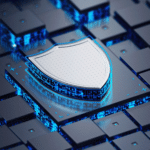Why Integrated IoT Security Accelerates Program Maturity

The rapid integration of Internet of Things (IoT) technologies in a business setting has enhanced how organizations conduct daily operations while simultaneously creating new security risks. Despite the increased use of these devices, the security tools available for managing them remain limited. Even more frustrating, fitting these monitoring tools into the organization’s cybersecurity technology and IT stacks is challenging.
Traditional IT security tools, like vulnerability scanners, often use active network scanning that can take IoT devices offline, meaning that organizations seek purpose-built solutions. However, without integrating these IoT monitoring tools into the organization’s overarching monitoring program, companies find themselves facing security blindspots arising from siloed data.
To protect data more effectively, organizations should consider how they can integrate IoT security to accelerate their program maturity.
What’s the security concern with IoT?
IoT devices gather data that people use to make informed decisions. Across every industry, these internet connected devices offer real-time insights that improve business outcomes. However, organizations should understand the various security concerns that these new technologies create.
Device heterogeneity and fragmentation
Device heterogeneity or fragmentation refers to the diversity and variation across the organization’s IoT fleet. As a new technology, IoT devices lack formal security and configuration standards, leading to the following challenges:
- Updating and controlling devices: IoT deployments often consist of devices from multiple manufacturers and with different operating systems, making it difficult to have a standardized approach for software updates and management.
- Interoperability: Different devices may use different communication protocols or standards, making it difficult for organizations to integrate them into the larger security program.
- Time-consuming and resource-intensive processes: Individuals responsible for IoT deployments need to have expertise and knowledge about various devices, their specifications, and compatibility issues.
Connection to valuable enterprise IT and operational technology (OT)
IoT devices, such as sensors, actuators, and smart devices, are interconnected and integrated into the organization’s IT or OT environments to collect and transmit real-time data. While this information enables the organization to make informed decisions, these network-connected devices create security challenges like:
- Device sprawl: Each new device connected to the network increases the organization’s attack surface, giving malicious actors more opportunities to exploit vulnerabilities and gain unauthorized access to sensitive systems and data.
- Shadow IT: Traditional IT asset discovery and inventory are not equipped to detect all IoT devices, leaving organizations with unmanaged devices that lack appropriate security monitoring.
- Third-party vendor risk: IoT device manufacturers are often slow to supply firmware or software updates for identified device vulnerabilities, creating risks to corporate and OT networks as malicious actors can exploit these unpatched security weaknesses.
Security issues with legacy devices
Legacy devices typically contain outdated firmware or operating systems while lacking modern security features. Many of these devices – like imaging machines in hospitals – were never intended to be connected to a network, but the cost of replacement is too burdensome. These devices create unique security issues, like:
- Limited processing power and memory: The devices lack capabilities necessary for implementing strong security measures, like encryption.
- Weak authentication: Legacy devices were not designed with network connectivity in mind, often leading them to lack proper authentication protocols or use weak default passwords that malicious actors can exploit to gain unauthorized access to systems, networks, and data.
Critical IoT Security Integrations to Accelerate Program Maturity
As companies begin to understand these security risks, they seek to find solutions for discovering, securing, and monitoring IoT devices. When considering an IoT discovery and management solution, organizations should consider how it integrates into their overarching IT and cybersecurity technology stacks.
Dynamic Host Configuration Protocol (DHCP)/IP Address Management (IPAM)
DHCP and IPAM technologies help monitor activity on the IP addresses allocated to the organization’s networks. Integrating IoT device information into this monitoring enables organizations to:
- Track devices as they move across the network, providing visibility into their physical location as they move around an organization’s campus.
- More accurate device classification and vulnerability identification
IT Service Management (ITSM)
IT teams use ITSM technologies to manage daily operations, like assigning responsibility for activities and tracking processes. Integrating IoT device information into these solutions enables organizations to:
- Create tickets for vulnerabilities identified in the devices
- Track vulnerability remediation activities
- Streamline workflows by automatically escalating the highest priority tasks for remediation
Vulnerability Management Tools
Vulnerability management tools typically use active network scanning to identify connected devices and their vulnerabilities. Integrating IoT device information into these solutions enables organizations to:
- Gain more information about all devices connected to their networks, IoT and traditional
- Prioritize and filter out irrelevant common vulnerabilities and exposures (CVEs)
- Populate scan/no-scan lists inside the vulnerability management tool to prevent it from taking IoT devices offline
Configuration Management Database (CMDB)/Computerized Maintenance Management System (CMMS)
CMDBs and CMMs tools store the list of secure configurations and enable IT teams to document changes to these configurations. Integrating IoT device information into these solutions enables organizations to:
- Synchronize data bidirectionally to continuously update the IoT and IT documentation
- Automatically update data, including information like IP address, software version, and location
- Reduce manual effort maintaining multiple management and maintenance systems
- Respond to incidents more rapidly
Security Information and Event Management (SIEM)
A SIEM analyzes the logs that the IT and cybersecurity technologies generate, identifying anomalies that can indicate a potential security incident. Integrating IoT device information into these solutions enables organizations to:
- Enrich security alerts with information about IoT devices
- Incorporate technical forensic data generated by IoT devices, like server RAM, network device traffic information, and data transferred to an FTP server
- Respond to incidents more rapidly by identifying potentially compromised IoT assets
Network Access Control (NAC) Devices
A NAC ensures that only authenticated users and devices can access a network, enforcing organizational policies to help manage endpoints. Integrating IoT device information into these solutions enables organizations to:
- Enforce policies for IoT devices, like blocking one from a network or applying a recommendation
- Add context about an IoT device’s category and risk score
- Quarantine devices involved in an anomaly
- Improve segmentation and micro segmentation policies
Threat Intelligence Feeds
Threat intelligence feeds provide insight into real-world threat actor activity, like current vulnerability exploits and tactics, techniques, and procedures (TTPs). Integrating IoT device information into these solutions enables organizations to:
- Enrich anomaly alerts with threat intelligence focused on IoT devices
- Use context about IoT devices to investigate alerts and their root cause
Endpoint Detection and Response (EDR) Tools
EDR tools are software downloaded onto a device that can detect and investigate threats, often including capabilities like anti-virus/anti-malware, data encryption, access controls, patch management. Integrating IoT device information into these solutions enables organizations to:
- Enriched understanding of the IoT device by gather on-device detection data from endpoint agents
- Enhance risk assessments by combining network-based and on-device detection
Use Asimily to Integrate IoT Security and Accelerate Program Maturity
Built to provide insights into IoT device security, the Asimily platform easily integrates into an organization’s overarching IT and security technology stack. It’s built to monitor traffic to and from IoT equipment and surface anomalous behavior that might indicate an attack in progress.
Asimily also provides vulnerability information on high-risk weaknesses with our proprietary algorithm that leverages vast amounts of data from resources like EPSS (Exploit Prediction Scoring System), Software Bills of Material (SBOMs), Common Vulnerability and Exposure (CVE) lists, the MITRE ATT&CK Framework, and NIST Guidelines. This insight empowers security teams to make efficient prioritization decisions and resolve the riskiest vulnerabilities quickly.
Customers also receive peace of mind from knowing what systems are attached to their networks and which ones need the most mitigations. With this insight, as well as improved monitoring, Asimily customers can better defend their IoT systems and critical information from threat actors.
To learn more about Asimily, download our IoT Device Security in 2024: The High Cost of Doing Nothing whitepaper or contact us today.
Secure Every IoT Device.
Automatically.
Cyber threats move fast — so should you. Asimily gives instant inventory and smart, prioritized risk mitigation insights for every IoT, OT, and IoMT device — so you can take action before threats strike.




